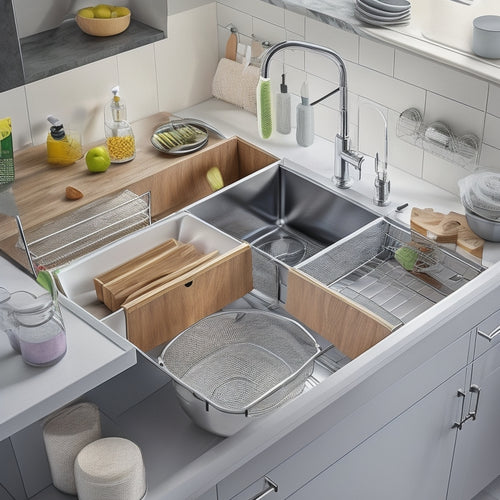
Easy Kitchen Cabinet Organization for Beginners
Share
You're about to transform your kitchen cabinets from cluttered and chaotic to streamlined and efficient! Start by evaluating your cabinet space and contents, identifying cluttered areas, and purging broken or unused items. Categorize your kitchen essentials into groups like baking, cooking, and serving, and assign a home for each item. Maximize storage with shelves, hooks, and dividers, and utilize corner space with carousel shelves or lazy Susans. With a solid plan in place, you're ready to take your kitchen cabinet organization to the next level - and we'll show you how to make it happen.
Key Takeaways
• Examine your kitchen cabinet layout, dimensions, and contents to identify cluttered, inefficient, or underutilized areas and optimize storage.
• Purge broken, expired, or unused items, and sort remaining items into categories like baking, cooking, and serving to create a functional storage system.
• Maximize storage solutions by installing shelves, hooks, or pegboards, and using vertical dividers, stacking bins, and lazy Susans to separate and organize items.
• Choose and install organizers that match your kitchen's style and layout, ensuring they are adjustable and customizable to fit your needs.
• Establish a regular maintenance routine to keep cabinets clutter-free, including weekly tidying, labeling, and implementing a 'one in, one out' policy.
Assessing Your Kitchen Cabinet Space
Take stock of your kitchen cabinet space by carefully examining the layout, dimensions, and contents of each cabinet to identify areas that are cluttered, inefficient, or underutilized. This thorough space evaluation is the first step in the decluttering process, allowing you to pinpoint problem areas and develop a plan to optimize your cabinet organization.
As you examine each cabinet, take note of the items you use regularly and those that are stored away for special occasions. Consider the frequency of use, the size and shape of items, and how they relate to each other. This will help you determine the most effective layout for your cabinets.
Next, think about the 'zones' in your kitchen – areas dedicated to specific tasks, such as food preparation or storage. Consider how you can allocate cabinet space to support these zones, ensuring that frequently used items are easily accessible.
Purging Unwanted Kitchen Items
Now that you've assessed your kitchen cabinet space, it's time to tackle the clutter.
You'll need to get rid of items that are broken, expired, or no longer useful - be ruthless, as these items are only taking up valuable space.
Next, sort and categorize the remaining items into groups, such as baking supplies, cooking utensils, and dinnerware, to get a sense of what you're working with.
Toss the Trash
By dedicating a few hours to sorting through your kitchen's contents, you'll be amazed at how many unnecessary items you've accumulated over time. It's important to tackle trash organization and decluttering before you can effectively organize your kitchen cabinets. Start by gathering trash bags and a recycling bin, and get ready to part with items that are no longer serving a purpose.
Some items that are likely taking up valuable space in your kitchen include:
- Broken or chipped dishes and utensils
- Expired or spoiled food items
- Duplicate appliances or gadgets
- Old cookbooks or recipe cards
- Stained or worn-out kitchen towels and oven mitts
As you sort through your kitchen items, be ruthless - if you haven't used it in the past year, it's probably safe to get rid of it.
Proper waste disposal and maintaining kitchen cleanliness are important in creating a functional and organized space. By eliminating the unnecessary, you'll be able to focus on organizing the items that bring value to your kitchen.
Sort and Categorize
With your kitchen cleared of trash and recyclables, categorize your remaining items into groups, such as baking supplies, cooking utensils, and dinnerware, to better assess what you have and where it should be stored. This step will help you identify what you need to keep, what you can donate or sell, and what you can discard.
Create a labeling system to categorize your items, using color coding to distinguish between groups. For instance, use blue labels for baking supplies and red labels for cooking utensils.
Next, use drawer dividers and storage bins to separate and store your categorized items. This will keep similar items together, making it easier to find what you need when you need it.
Be ruthless – if you haven't used an item in the past year, it's probably safe to get rid of it. By sorting and categorizing your kitchen items, you'll be able to see what you have, what you need, and where everything should go. This will make the rest of your kitchen organization process much smoother and more efficient.
Categorizing Kitchen Essentials
You'll need to group your kitchen essentials into categories to create a functional and efficient storage system. This will help you assign a home for each item, making it easier to find what you need when you need it.
Start by categorizing your kitchen tools, such as utensils, gadgets, and cookware, into groups like baking, cooking, and serving.
Here are some examples of categories to get you started:
-
Baking essentials: mixing bowls, measuring cups, whisks
-
Cooking utensils: pots, pans, spatulas, tongs
-
Servingware: plates, glasses, silverware
-
Pantry staples: dry goods, canned goods, spices
-
Cleaning supplies: sponges, dish soap, trash bags
Maximizing Vertical Storage
Now that you've categorized your kitchen essentials, it's time to think vertically and make the most of your cabinet space by installing shelves, hooks, or a pegboard to hang items like pots, pans, and utensils. This will help you optimize your storage capacity and keep frequently used items within easy reach.
Consider installing vertical dividers to separate and organize items like plates, bowls, and cups. You can also use hanging hooks to hang items like tea towels, aprons, or even a cookbook.
To maximize storage, use stacking bins or tiered racks to store dry goods like pasta, rice, or canned goods. Label each bin or rack so you can easily find what you need. Additionally, consider installing a lazy Susan or turntable to make it easy to access items in the back of your cabinet.
Utilizing Corner Cabinet Solutions
Now that you've maximized your vertical storage, it's time to turn your attention to the often-wasted space in your kitchen's corners.
You'll want to optimize this area by selecting a corner cabinet solution that fits your needs, whether that's a carousel, Lazy Susan, or adjustable shelving system.
Optimizing Corner Space
Corner cabinets, often the most underutilized spaces in your kitchen, can be transformed into highly functional areas with the right solutions. By optimizing corner space, you can increase storage capacity, reduce clutter, and make your kitchen feel more spacious.
Here are some space-saving options to contemplate:
-
Carousel shelves that rotate to bring items to the front
-
Lazy Susans with removable baskets for easy access
-
Tiered shelving units with adjustable heights
-
Pull-out drawers with dividers for organized storage
-
Adjustable corner baskets that fit snugly into the cabinet
Efficient Shelving Systems
By incorporating the right shelving systems into your corner cabinets, you can maximize storage capacity and create a seamless workflow in your kitchen.
One effective solution is to install pull-out shelves, which allow you to easily access items in the back of the cabinet without having to dig through everything.
You can also consider a Lazy Susan, which rotates to bring items to you, making it easy to find what you need.
To further optimize your corner cabinet space, consider adding under-cabinet storage. This can include slide-out drawers or baskets that fit neatly under the cabinet, providing additional storage for utensils, spices, or other kitchen essentials.
Don't forget to use drawer dividers to keep items organized and easy to find.
By incorporating these shelving systems, you'll be able to find what you need quickly and efficiently, making meal prep and cooking a breeze.
With a little creativity and planning, you can turn your corner cabinets into a functional and organized space that makes your kitchen workflow smoother than ever.
Designing a Functional Layout
You'll need to evaluate your kitchen's unique dimensions and workflow patterns to design a functional cabinet layout that accommodates your specific needs. This means contemplating the 'work zones' in your kitchen, such as cooking, prep, and storage areas.
A well-designed layout will optimize space utilization, making the most of your kitchen's design.
Here are some key factors to ponder when designing your functional layout:
-
Identify the 'golden triangle' of your kitchen, where the sink, stove, and fridge form the points of a triangle, and prioritize cabinet placement accordingly.
-
Allocate cabinet space based on the frequency of use, with daily essentials in easy-to-reach locations.
-
Ponder the height and depth of your cabinets to ensure comfortable access and efficient storage.
-
Leave enough clearance between cabinets and countertops for easy movement and workflow.
-
Plan for a 'landing strip' near the entrance of your kitchen, where you can place keys, mail, and other essentials.
Choosing the Right Organizers
With your functional layout in place, it's time to select the perfect organizers that will maximize your cabinet space and keep your kitchen essentials within easy reach.
When it comes to pantry organization, consider adjustable shelves, baskets, or bins that can be customized to fit your specific needs. These will help you store dry goods, snacks, and other pantry staples in a logical and accessible way.
For your drawers, use dividers to separate utensils, cookware, and dinnerware. This will prevent clutter from building up and make it easier to find what you need when you need it.
You can also install a spice rack on the back of a cabinet door or on a wall to keep your spices organized and within reach. A pot lid holder is another great addition, keeping your lids tidy and freeing up space in your cabinets.
Remember to choose organizers that fit your kitchen's unique style and layout. Measure your cabinets and drawers carefully before making a purchase, and consider the types of items you need to store.
Installing Adjustable Shelves
Two adjustable shelves can be installed in a standard 30-inch wide cabinet, providing ample storage space for your kitchen essentials. This allows you to customize your shelf layout according to your needs, making the most of the available space.
Adjustable shelving is a great space-saving solution, as it enables you to adjust the shelf height to accommodate items of varying sizes.
Here's what you can expect to achieve with adjustable shelves:
-
Easy access: Place frequently used items on lower shelves, and less frequently used items on higher or lower shelves.
-
Customized storage: Store large or bulky items, like cookbooks or appliances, on shelves with more vertical space.
-
Maximized capacity: Fit more items on each shelf, thanks to the adjustable height feature.
-
Reduced clutter: Keep your countertops clear by storing items that would otherwise clutter your kitchen.
-
Flexible organization: Reconfigure your shelves as your kitchen needs change over time.
Optimizing Cabinet Shelf Space
Now that you've installed adjustable shelves, it's time to optimize the cabinet shelf space by strategically arranging your kitchen essentials to maximize storage capacity and efficiency. This involves categorizing items into groups, such as baking supplies, cooking utensils, and dinnerware, and assigning a specific shelf or area for each group.
To optimize shelf space, consider the following arrangement strategies:
| Category | Shelf Assignment | Additional Tips |
|---|---|---|
| Baking Supplies | Top Shelf | Store heavy items, like mixing bowls, towards the front for easy access |
| Cooking Utensils | Middle Shelf | Use drawer dividers to separate items, like wooden spoons and spatulas |
| Dinnerware | Bottom Shelf | Labeling solutions, like stickers or chalkboard labels, help identify contents |
| Snacks and Spices | Top Shelf | Store frequently used items in easy-to-reach locations |
| Infrequently Used Items | Bottom Shelf | Consider storing items, like special occasion dishes, towards the back |
Maintaining Your Organized Cabinets
You'll need to establish a regular maintenance routine to make certain your newly organized cabinets remain clutter-free and functional. This will guarantee that all your hard work doesn't go to waste and that you can continue to enjoy the benefits of an organized kitchen.
Here are some tips to help you maintain your organized cabinets:
-
Set a weekly cleaning schedule to wipe down shelves and tidy up any clutter that may have accumulated.
-
Stick to your labeling system, and make sure everything is returned to its designated spot after use.
-
Implement a 'one in, one out' policy to prevent clutter from building up again.
-
Regularly assess your storage solutions and make adjustments as needed.
-
Schedule a deeper clean of your cabinets every 3-6 months to remove any dust, dirt, or expired items.
Related Posts
-

Boost Productivity With Free Google Sheets Templates
You can enhance your productivity exponentially by utilizing free Google Sheets templates, which offer a proven way t...
-

Affordable Amazon Home Improvement Must-Haves
You're one step away from a more organized, stylish, and functional living space! Start with must-haves like mDesign'...
-

LYNK PROFESSIONAL: Transform Your Under-Sink Storage
Transform your under-sink storage with LYNK PROFESSIONAL, a cleverly designed system that tackles common challenges. ...


